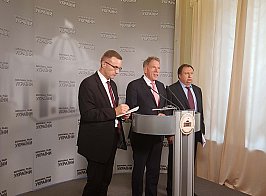International activity
“The Ukrainian-Polish border should become an internal border of the EU” Ivanna Klympush-Tsintsadze
On May 5-6, the Committee on Ukraine’s Integration into the European Union
and the European Union Advisory Mission Ukraine made a joint visit to the
Volyn and Lviv regions. The purpose of the visit was to assess the needs
of the Ukrainian-Polish border crossing points in terms of increasing
capacity, strengthening security, improving infrastructure, establishing
closer interdepartmental coordination, as well as the prospects of
international support for cross-border cooperation from the European Union
and other international partners.
During the first day, the delegation visited the border crossing points
Yagodyn in Volyn region and Ugryniv, Krakivets and Shehyni in Lviv region.
Members of the delegation examined the infrastructure and addressed
problems related to veterinary and phytosanitary control. They were joined
by representatives of ministries and departments, regional authorities,
the European Commission, the Delegation of the European Union to Ukraine,
EU projects dealing with issues of integrated border management, as well
as the International Organization for Migration.
The next day, an on-site meeting of the Committee on Ukraine’s Integration
into the EU was held, where the results of the trip and improving the
operation of Ukrainian-Polish border crossing points were discussed. It
focused on developments in the implementation of the Strategy of
integrated border management, support from the European Union and the
possibility of joint control on the Ukrainian-Polish border.
“It is important that representatives of the central executive authorities
and local self-government bodies, as well as our European partners
participated in the meeting after the working trip to the checkpoints.
Based on the results of the joint visit with the EUAM and the on-site
meeting of the Committee in Lviv, we will prepare official recommendations
for central and regional authorities to be implemented at the legislative,
executive level and in close cooperation between the Ukrainian and Polish
governments, as well as the European Union,” said the Chair of the
Committee Ivanna Klympush-Tsintsadze.
She emphasised that the Ukrainian-Polish border should become an internal
border of the EU: “Therefore we need to work out all the decisions
regarding the development of the border infrastructure, considering the
strategic goals. I am convinced that we should invest in mobile
infrastructure, which after Ukraine's accession to the EU, will be
transferred to the external border of the EU, which will be in the North
and East of Ukraine, after the Russian occupiers will be expelled from the
entire territory of Ukraine.” At the same time, she added that today,
unfortunately, the government's Integrated Border Management
Strategy does not consider important Schengen requirements. Also, an
automated exchange of information between Ukrainian customs officers and
border guards is not in place.
“The process of integrated border management is extremely important not
only for regulating queues at borders and creating a comfortable and safe
infrastructure. It should also solve the strategic task of connecting
Ukraine with the transport corridors of Europe. Ukraine is a very
important player in terms of its transit potential. Therefore, the focus
in not only on borders, but also on global changes in transport
connections in Europe”, the first deputy Chairman of the Committee, Vadym
Halaichuk said.
Secretary of the Committee Valentyn Nalyvaichenko emphasised that the
Ukrainian-Polish border is the border of allies. “That's why we have to
work together with Poland and the European Union to make the border free,
safe and comfortable for citizens” he said.
“The EUAM will continue to provide strategic advice and support to the
Ukrainian government, the State Border Guard Service and the State Customs
Service of Ukraine in the delivery of tasks related to the simplification
of trade procedures and the acquisition of the status of a candidate for
the EU accession. In this context, we discussed the importance of the
implementation of the EU legal provisions into Ukrainian law, coordinated
efforts to develop border crossing points and compliance of border and
customs control procedures with EU standards. A good example of such
interdepartmental and international cooperation and information exchange
is the Ukrainian-Romanian-Moldovan customs working group initiated by the
EUAM. In the future, we plan to invite to it representatives of Slovakia
and Poland,” emphasised Jorg Einemann, Head of Integrated Border
Management Unit at EUAM Ukraine.

